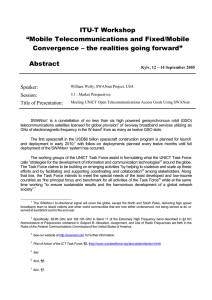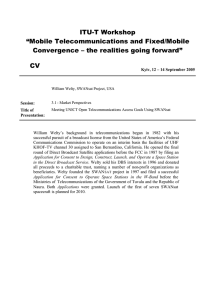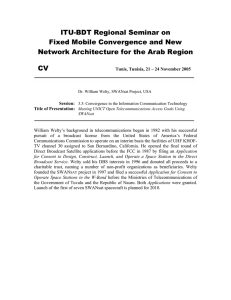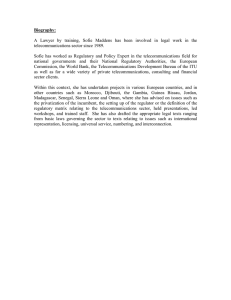SWAN is a constellation of no ... telecommunications satellites licensed for global provision
advertisement
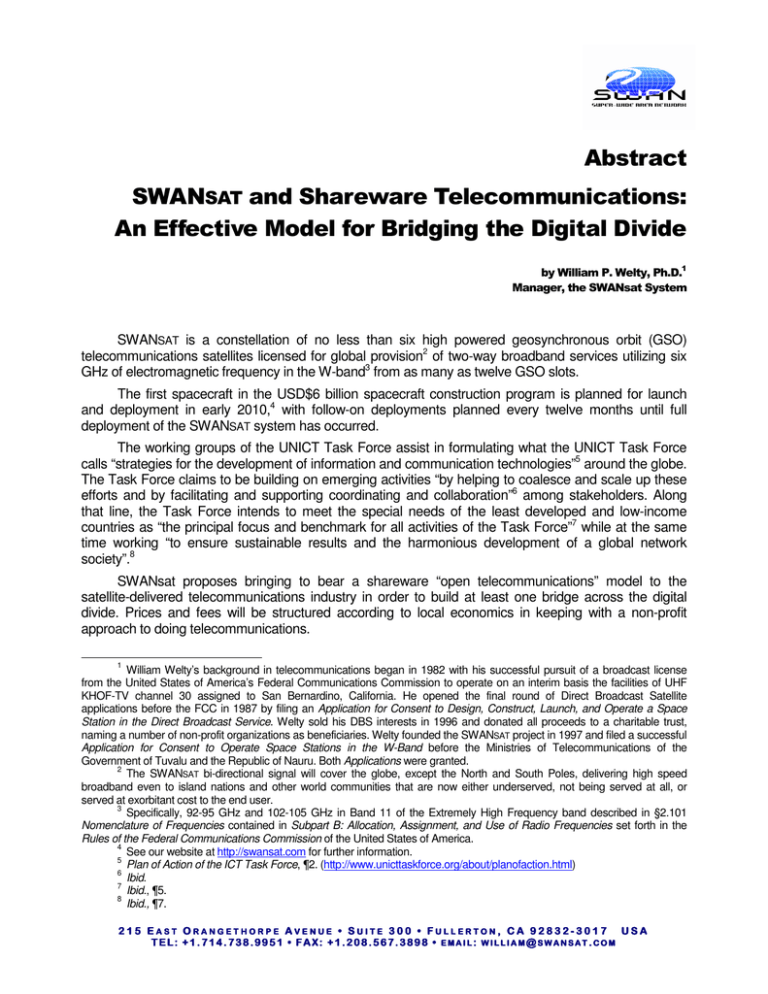
! " ! !# " SWANSAT is a constellation of no less than six high powered geosynchronous orbit (GSO) telecommunications satellites licensed for global provision2 of two-way broadband services utilizing six GHz of electromagnetic frequency in the W-band3 from as many as twelve GSO slots. The first spacecraft in the USD$6 billion spacecraft construction program is planned for launch and deployment in early 2010,4 with follow-on deployments planned every twelve months until full deployment of the SWANSAT system has occurred. The working groups of the UNICT Task Force assist in formulating what the UNICT Task Force calls “strategies for the development of information and communication technologies”5 around the globe. The Task Force claims to be building on emerging activities “by helping to coalesce and scale up these efforts and by facilitating and supporting coordinating and collaboration”6 among stakeholders. Along that line, the Task Force intends to meet the special needs of the least developed and low-income countries as “the principal focus and benchmark for all activities of the Task Force”7 while at the same time working “to ensure sustainable results and the harmonious development of a global network society”.8 SWANsat proposes bringing to bear a shareware “open telecommunications” model to the satellite-delivered telecommunications industry in order to build at least one bridge across the digital divide. Prices and fees will be structured according to local economics in keeping with a non-profit approach to doing telecommunications. 1 William Welty’s background in telecommunications began in 1982 with his successful pursuit of a broadcast license from the United States of America’s Federal Communications Commission to operate on an interim basis the facilities of UHF KHOF-TV channel 30 assigned to San Bernardino, California. He opened the final round of Direct Broadcast Satellite applications before the FCC in 1987 by filing an Application for Consent to Design, Construct, Launch, and Operate a Space Station in the Direct Broadcast Service. Welty sold his DBS interests in 1996 and donated all proceeds to a charitable trust, naming a number of non-profit organizations as beneficiaries. Welty founded the SWANSAT project in 1997 and filed a successful Application for Consent to Operate Space Stations in the W-Band before the Ministries of Telecommunications of the Government of Tuvalu and the Republic of Nauru. Both Applications were granted. 2 The SWANSAT bi-directional signal will cover the globe, except the North and South Poles, delivering high speed broadband even to island nations and other world communities that are now either underserved, not being served at all, or served at exorbitant cost to the end user. 3 Specifically, 92-95 GHz and 102-105 GHz in Band 11 of the Extremely High Frequency band described in §2.101 Nomenclature of Frequencies contained in Subpart B: Allocation, Assignment, and Use of Radio Frequencies set forth in the Rules of the Federal Communications Commission of the United States of America. 4 See our website at http://swansat.com for further information. 5 Plan of Action of the ICT Task Force, ¶2. (http://www.unicttaskforce.org/about/planofaction.html) 6 Ibid. 7 Ibid., ¶5. 8 Ibid., ¶7. ! " # $ # % $ #
